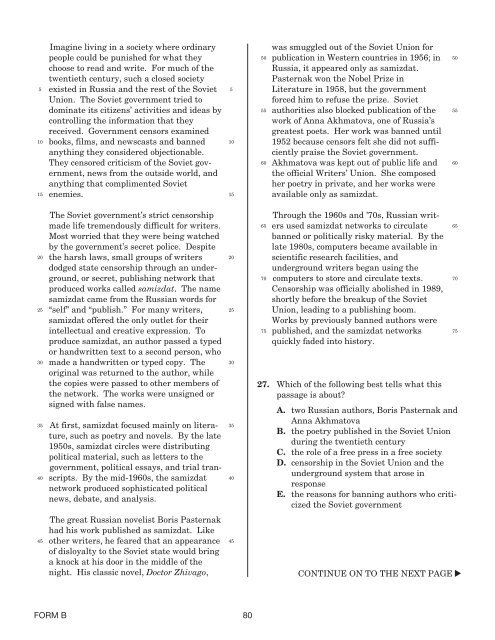2016SHSAT_English
2016SHSAT_English
2016SHSAT_English
Create successful ePaper yourself
Turn your PDF publications into a flip-book with our unique Google optimized e-Paper software.
51015Imagine living in a society where ordinarypeople could be punished for what theychoose to read and write. For much of thetwentieth century, such a closed societyexisted in Russia and the rest of the SovietUnion. The Soviet government tried todominate its citizens’ activities and ideas bycontrolling the information that theyreceived. Government censors examinedbooks, films, and newscasts and bannedanything they considered objectionable.They censored criticism of the Soviet government,news from the outside world, andanything that complimented Sovietenemies.51015505560was smuggled out of the Soviet Union forpublication in Western countries in 1956; inRussia, it appeared only as samizdat.Pasternak won the Nobel Prize inLiterature in 1958, but the governmentforced him to refuse the prize. Sovietauthorities also blocked publication of thework of Anna Akhmatova, one of Russia’sgreatest poets. Her work was banned until1952 because censors felt she did not sufficientlypraise the Soviet government.Akhmatova was kept out of public life andthe official Writers’ Union. She composedher poetry in private, and her works wereavailable only as samizdat.5055602025303540The Soviet government’s strict censorshipmade life tremendously difficult for writers.Most worried that they were being watchedby the government’s secret police. Despitethe harsh laws, small groups of writersdodged state censorship through an underground,or secret, publishing network thatproduced works called samizdat. The namesamizdat came from the Russian words for“self” and “publish.” For many writers,samizdat offered the only outlet for theirintellectual and creative expression. Toproduce samizdat, an author passed a typedor handwritten text to a second person, whomade a handwritten or typed copy. Theoriginal was returned to the author, whilethe copies were passed to other members ofthe network. The works were unsigned orsigned with false names.At first, samizdat focused mainly on literature,such as poetry and novels. By the late1950s, samizdat circles were distributingpolitical material, such as letters to thegovernment, political essays, and trial transcripts.By the mid-1960s, the samizdatnetwork produced sophisticated politicalnews, debate, and analysis.2025303540657075Through the 1960s and ’70s, Russian writersused samizdat networks to circulatebanned or politically risky material. By thelate 1980s, computers became available inscientific research facilities, andunderground writers began using thecomputers to store and circulate texts.Censorship was officially abolished in 1989,shortly before the breakup of the SovietUnion, leading to a publishing boom.Works by previously banned authors werepublished, and the samizdat networksquickly faded into history.27. Which of the following best tells what thispassage is about? A. two Russian authors, Boris Pasternak andAnna AkhmatovaB. the poetry published in the Soviet Unionduring the twentieth centuryC. the role of a free press in a free societyD. censorship in the Soviet Union and theunderground system that arose inresponseE. the reasons for banning authors who criticizedthe Soviet government65707545The great Russian novelist Boris Pasternakhad his work published as samizdat. Likeother writers, he feared that an appearanceof disloyalty to the Soviet state would bringa knock at his door in the middle of thenight. His classic novel, Doctor Zhivago,45CONTINUE ON TO THE NEXT PAGEFORM B80



